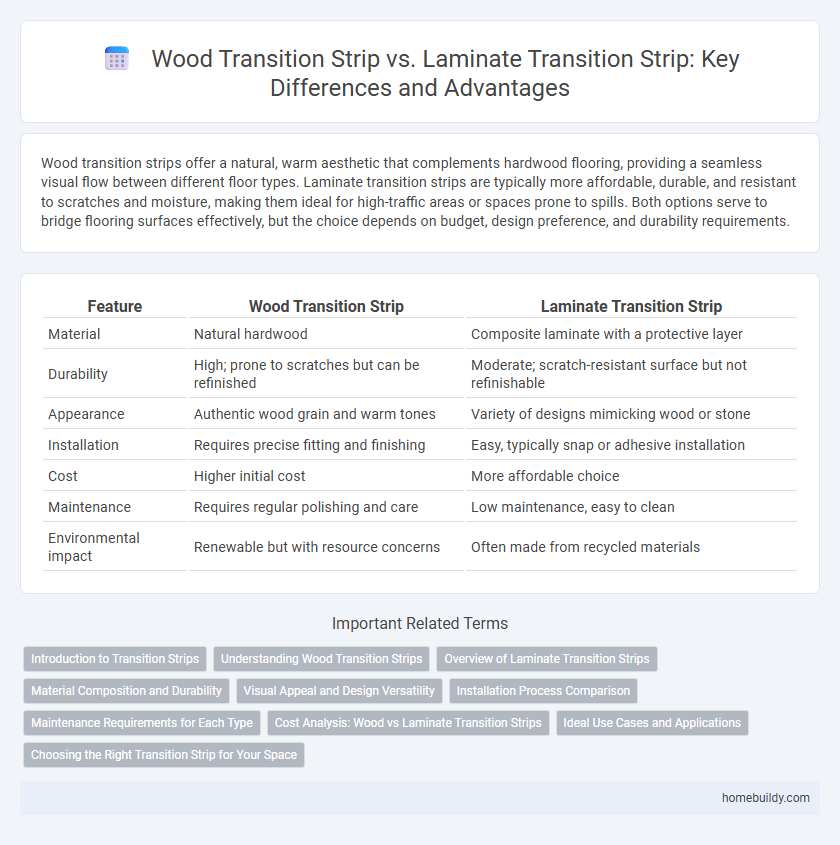Wood transition strips offer a natural, warm aesthetic that complements hardwood flooring, providing a seamless visual flow between different floor types. Laminate transition strips are typically more affordable, durable, and resistant to scratches and moisture, making them ideal for high-traffic areas or spaces prone to spills. Both options serve to bridge flooring surfaces effectively, but the choice depends on budget, design preference, and durability requirements.
Table of Comparison
| Feature | Wood Transition Strip | Laminate Transition Strip |
|---|---|---|
| Material | Natural hardwood | Composite laminate with a protective layer |
| Durability | High; prone to scratches but can be refinished | Moderate; scratch-resistant surface but not refinishable |
| Appearance | Authentic wood grain and warm tones | Variety of designs mimicking wood or stone |
| Installation | Requires precise fitting and finishing | Easy, typically snap or adhesive installation |
| Cost | Higher initial cost | More affordable choice |
| Maintenance | Requires regular polishing and care | Low maintenance, easy to clean |
| Environmental impact | Renewable but with resource concerns | Often made from recycled materials |
Introduction to Transition Strips
Transition strips are essential flooring components designed to bridge gaps between different floor types, ensuring a smooth, safe surface. Wood transition strips provide a natural, warm aesthetic ideal for traditional or hardwood floors, while laminate transition strips offer durability and resistance to moisture, making them suitable for high-traffic or water-prone areas. Choosing between wood and laminate transition strips depends on flooring material compatibility, durability needs, and desired visual appeal.
Understanding Wood Transition Strips
Wood transition strips offer superior durability and a natural aesthetic, making them ideal for seamlessly connecting hardwood floors to other surfaces. Engineered from solid hardwood, these strips provide better resistance to wear and can be refinished to extend lifespan. In comparison to laminate transition strips, wood strips enhance home value and maintain consistent color and grain patterns, ensuring a cohesive flooring transition.
Overview of Laminate Transition Strips
Laminate transition strips are specifically designed to bridge flooring surfaces made of laminate, providing a smooth and visually consistent transition. These strips feature durable materials that resist wear and moisture, ensuring longevity in high-traffic areas. Compared to wood transition strips, laminate options offer easier installation and better compatibility with the expansion and contraction characteristics of laminate flooring.
Material Composition and Durability
Wood transition strips are composed of natural hardwood, providing a sturdy and aesthetically pleasing option with excellent durability against everyday wear and tear. Laminate transition strips are made from engineered materials with a melamine surface layer that offers resistance to scratches and moisture but may lack the longevity of solid wood under heavy use. The choice between wood and laminate transition strips depends on the desired balance between authentic appearance and maintenance requirements.
Visual Appeal and Design Versatility
Wood transition strips offer a warm, natural aesthetic that enhances traditional and rustic interiors with rich grain patterns and authentic texture. Laminate transition strips provide greater design versatility through a wide range of colors, finishes, and customizable styles that mimic various wood species or contemporary looks. Choosing between them depends on the desired visual appeal and flexibility to complement specific flooring designs.
Installation Process Comparison
Wood transition strips typically require precise measurement, cutting, and securing with nails or adhesive, making the installation process more labor-intensive and time-consuming. Laminate transition strips often feature click-and-lock or adhesive backing systems that allow for faster, simpler installation without the need for specialized tools. The choice between wood and laminate transition strips depends on the desired durability and ease of installation tailored to the flooring type.
Maintenance Requirements for Each Type
Wood transition strips require regular cleaning with a damp cloth and periodic sealing or refinishing to protect against moisture and wear, ensuring longevity and appearance. Laminate transition strips demand minimal maintenance, needing only routine dusting and occasional wiping with a mild cleaner, as they resist scratches and moisture more effectively than wood. Choosing between these options depends on the desired balance between aesthetic appeal and ease of upkeep for flooring transitions.
Cost Analysis: Wood vs Laminate Transition Strips
Wood transition strips typically cost significantly more than laminate transition strips due to higher material and manufacturing expenses. Laminate transition strips offer an affordable alternative while still providing durability and a similar aesthetic appeal. Choosing laminate strips can reduce installation expenses and maintenance costs, making them a cost-effective solution for budget-conscious projects.
Ideal Use Cases and Applications
Wood transition strips are ideal for traditional interior designs and spaces where durability and natural aesthetics are important, such as living rooms and bedrooms with hardwood flooring. Laminate transition strips suit high-traffic areas and commercial settings due to their resistance to moisture and wear, making them perfect for kitchens, hallways, and office spaces. Choosing between wood and laminate hinges on factors like moisture exposure, foot traffic, and desired visual continuity.
Choosing the Right Transition Strip for Your Space
Wood transition strips offer natural durability and classic aesthetics that blend seamlessly with hardwood floors, providing enhanced stability along floor edges. Laminate transition strips, designed for compatibility with laminate flooring, are typically more cost-effective and resistant to moisture, making them ideal for high-traffic or humid areas. Selecting the right transition strip depends on floor type, environmental conditions, and desired visual cohesion, ensuring a smooth, safe transition between different flooring surfaces.
Wood transition strip vs Laminate transition strip Infographic

 homebuildy.com
homebuildy.com